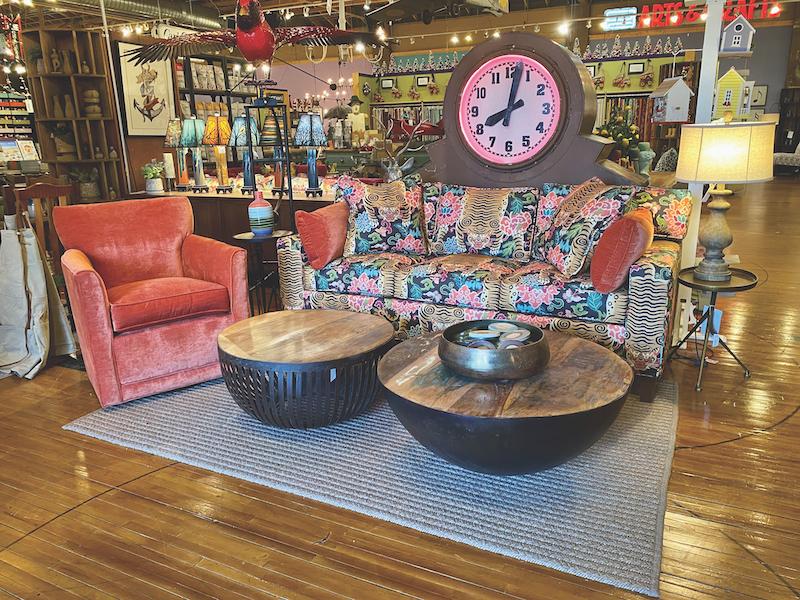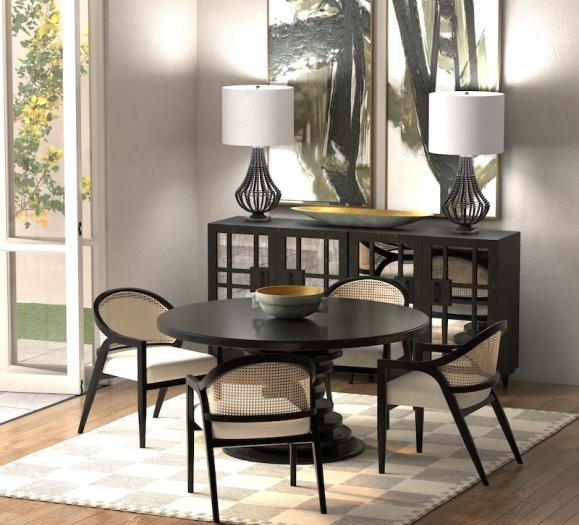How do buyers determine the merchandise they are putting on their showroom floor, and then convince their patrons to go from browsing to buying? How do designers sway their clients toward timeless home furnishings that meet their functionality needs as well as the right aesthetic? For retailers and designers, determining the furnishings and accents they have on the showroom floor or offer to their design clients requires far more than just what’s on trend. Trends may not actually influence customer/client decisions as much as one might expect.
Customer lifestyles and the functionality, as well as timeless appeal are far more important to both designers and home furnishings retailers. “Trend lightly,” is a motto of Houston-based Design House and Fabric House Owner Connie LeFevre. As an interior designer and retailer, she considers herself a solutions provider for her customers and design clients. “I help people create environments. Our mission here is to create functional environments that are beautiful and work for our clients’ lifestyles.” Creating those environments that stand the test of time often means focusing more on function and less on what’s trending at the moment. Instead, LeFevre considers overarching wants and needs, such as customers wanting environments designed for health and wellness, sustainability and even technology. “Designers have a big responsibility as we have an impact on the community,” she says.
Shayla Copas, Founder of Shayla Copas Interiors, also assesses her clients’ lifestyles before determining and persuading them as to what will work best in their homes. “With our clients, we have an in-depth intake form,” she says. “We get to know what our clients like, and the taste and direction they want during that process.” Sometimes, she adds, clients are stuck on a color scheme or another design detail that she knows just won’t hold up in the long run. “We’ll show them the green and orange [for example] ,and then we’ll also show a design option based on what we discussed,” Copas says. “They hired us because we’re professionals and nine times out of 10, our clients go with what we think is best. They rarely go in the direction they started with.”
As trends go, too, Copas is transparent with her clients about what’s happening now and what can be expected a couple of years from now. “If you love gray and that makes you feel good in that space, you need to know what’s going to happen with that color so you’re not surprised when you go to friends’ houses and they all have warmer colors.”
Copas also assesses how often her clients entertain, what that looks like and how it will impact furniture placement and other elements in a room design. “We choose to be up front about everything that happens in a project so everyone will be happy in the end. I’m also respectful of my clients because this is their home.”
Even on the retail showroom floor, it’s important to have conversations with customers to ensure the pieces they go home with will fit lifestyles. “We always start by talking about their lives,” Mary Liz Curtin, Owner of Leon & Lulu, in Clawson, MI, says. “How many pets? Do you sleep here? Do you eat here? How many kids, dogs, husband, other weapons of destruction? What will make your life better?”
A driving factor for furniture buying at Leon & Lulu is that it’s durable and saleable. “We have everything you need in a sofa, sideboard…they are worry-free and the right size,” she says. “We consult with them to know what they need. Do you have a place for a lamp and a table at the end of the sofa? These are things they might not think about as they aren’t professionals in this field.” Curtin understands her community too, which is made up of primarily smaller homes. When sourcing furniture, she is careful to not bring in sofas with overstuffed arms, for example.
Curtin also understands the Leon & Lulu customer and what they are looking for. She keeps her best-selling sofa frame available and she never covers a sofa in a fabric that won’t wear well. That doesn’t mean, however, that Curtin doesn’t take risks with some of the choices on the showroom floor. “The big job is finding aspirational, interesting and inspiring pieces,” she says. “People come in and they look at the wacky, wonderful stuff and then they buy a neutral sofa. But they’re thrilled that they bought it in the store that has the magic. It’s amazing.”
To create that magic, Curtin merchandises with color and pattern. Currently, she has a sofa as a centerpiece that is covered in a chinoiserie tiger pattern. It’s on trend, and it starts the conversations. “We find that our customers want to have a little bit more fun once we get them a little less afraid [of such things as color and pattern].”
Curtin dresses up her neutrals by allowing customers to customize with pillows. “We play pillow games all the time. Every sofa comes with two pillows. We’ll run around and get eight sets of pillows for you to choose from to see which one works for you. Pillows are really fun.” Pillows are also a place to test color and pattern and trending styles.
Inspired Buying
For retailers and designers, it’s important to stay abreast of trends, but it’s also important to know what will work for customers. Curtin keeps her staples on the showroom floor, such as that bestselling sofa frame. “I would rather have a trustworthy best seller on the floor than new unproven merchandise,” she says.
However, Curtin also knows that new is necessary to inspire her customers. To find those intriguing pieces, Curtin is a big proponent of trade shows. “We need to see things in person,” she says. “If I know it will delight my customer, I buy it immediately. I look for the stuff that will inspire my customers. I look for the excitement factor.” As a veteran retailer — Leon & Lulu incorporates home furnishings, gift and apparel — Curtin visits lots of markets, including Maison & Objet this year in Paris, where she gets inspiration for future furniture but buys gifts and fashion because her customers love that.
Before markets, too, Curtin prepares, making lists from trade magazines and paying attention to merchandise she sees in other stores. She also, once again, pays attention to her customers’ lifestyles. “During the pandemic, it was about how comfortable you would be in your home because you were stuck there,” she says. “Now the conversation is more about home entertaining, and people don’t want to spend as much time there so they aren’t looking for high-maintenance. They want to do things; they want to shop.”
For Curtin, it’s important that her vendors are knowledgeable about their offerings too. “Great salespeople help us make strategic plans and not just buy randomly because something is adorable. Instead of what’s new, I want to know what’s paying the sales rep’s mortgage,” she says, adding that it’s the mix of new and tried and true that really makes her store work.
LeFevre, of Design House and Fabric House, pays attention to overarching themes her customers and clients are paying attention to — biophilic design, for example — and trusts her instincts when it comes to finding new products. “We curate and edit the products we have, and we look for new ones,” she says. “I would be sad after doing this for so many years if I couldn’t see what’s coming. We’re not just salespeople here; we’re designers too.”
As a designer, LeFevre is looking for the products that will make her clients and customers happy, so she’s influenced by the solution mindset she starts out with. She attends markets with lists of requests that customers — some trade — have asked them to look for, and she pays attention to how the functionality will be as much as the aesthetic of a piece of furniture or a light fixture. “I have a sense of what works and what might not. I know the colors that are always good,” she says. “I’m at the market to learn about the products, not just look around. I want to be able to see how something sits, pull out drawers to assess the soft close, understand the technology advantage of a piece, as in does it have USB ports or charging? I want clients and customers to understand what makes them happy.”
And while her customer/client needs are the first influence, LeFevre does pay attention to colors, patterns and other trends she sees at market. “If it’s trending at market, it doesn’t mean it has staying power,” she cautions, so she acknowledges those trends but doesn’t push them.
LeFevre says she also looks for artisanal, creative things, “special pieces that we just don’t have in our library of resources.”
Influencing the New
For Shayla Copas, understanding the influences that are important to consumers goes beyond buying for her design clients. Copas also has several product collections with companies such as Chelsea House and, most recently, Prestige Art and Art Trends. Bringing new products to market requires an understanding of what’s fresh, but it also requires understanding what’s going to stand the test of time. “When I design, part of my design for a product uses my business head, and part has my love of color,” she says. “We develop 80 percent of what we believe will be marketable to retailers. It’s about sales for them and not my ego as the designer. However, 20 percent of the product I design is done with my heart and soul.”
Copas adds that she is careful with color. While she loves color and many of her products reflect that, you’ll also see a lot of cream, beige and gray because people are comfortable with non-committal colors. She adds that she collaborates with her vendors as well to ensure they are comfortable with the way a collection is shaping up. “I want to make sure what I’m designing is profitable for them,” Copas says, adding that when designing, she keeps her eye on cost as well. “No one tells me to do that, but it’s a decision I make. Little touches, such as silver or gold trim, can bring the cost up. I develop in a way that more consumers can have my products.”
While those practical considerations are important influences, Copas continues that she peruses trend forecasts and a color marketing group that showcases color trends about two years out. In addition, she is inspired by nature and travel. Travel is such an important influence in Copas’s aesthetic and product development, she is getting ready to launch a travel division to take designers on trips around the world so they can experience what Copas has been able to experience, as it’s had such a positive influence on her design choices, product development and overall business.







